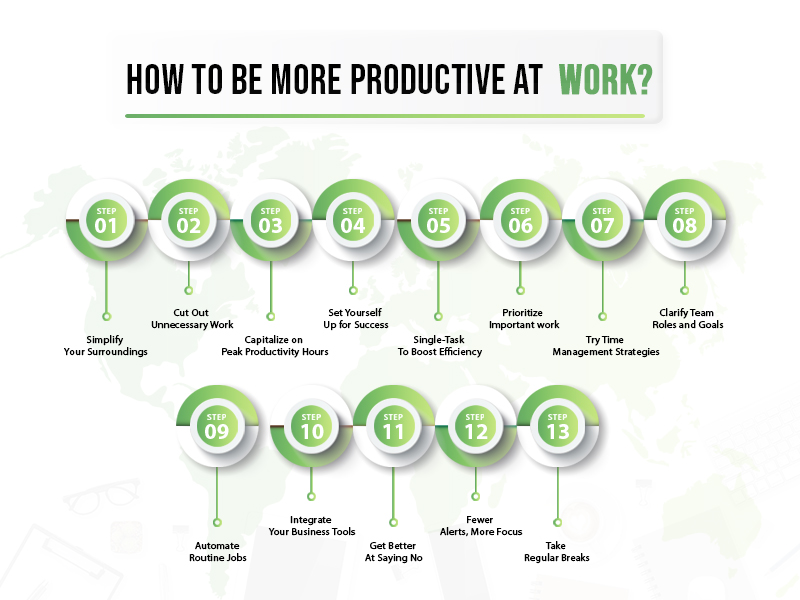Productivity is not merely about finishing as much work as possible. It is about being effective and working diligently. It is also composed of some high-value tasks, such as attending less, but more valuable meetings, instead of unnecessary meetings, or looking for and waiting for approval documents.
You don’t have to keep getting additional exercise to get increased productivity. You can begin by doing day-to-day activities that will help improve the situation.
Listed below are 13 simple steps to improve your productivity instantly. Find out how excellent work management tools boost your efficiency and enable you to avoid wasting time on meaningless tasks.
“Feeling swamped with tasks and struggling to find enough hours in the day? Consider hiring a virtual assistant! WorkStaff360 Virtual assistants can be a game-changer for your productivity. They’ll handle those time-consuming administrative tasks, freeing you up to focus on what matters most – growing your business or excelling in your role. Plus, virtual assistants offer a wider talent pool to choose from, allowing you to find someone with the exact skills you need at a cost-effective rate.“
You Will Learn
ToggleHow to be productive at work?
Being productive is sometimes misunderstood as more quantity of work but it refers to enhancing the quality of work done. Being efficient in your working hours without getting tired is what is required for productivity.
Below are 13 important tips which promise great productivity at work. Use these tips to be more efficient in performing routine-wise to-do lists. These are completely actionable during your working hours.

Let’s just uncover them in detail:
-
Simplify Your Surroundings
Problem: Leaving your desk in a disordered way can distract you.
Solution: Keep your desk organized.How It Works:
Frequently tidy your work area and limit yourself to what you are using right at the moment. Make sure to get holders for smaller things and papers, and get rid of the stuff/trash you don’t need daily. A slightly tidy desk helps you stay on to one job with no more distractions.
Example:
A painter could have plenty of brushes and paint tubes on their palette. When they keep only a few brushes, paints, canvases, cleaning items, and other materials they need for the drawing, they can concentrate on what they’re doing.Benefits:
- Minimizes the level of distractions, bringing about better focus of attention.
- It also saves time one would have to spend searching for the items.
- Helps to establish an atmosphere of peace that may in turn boost creativity.
-
Try Time Management Strategies
Problem: It is hard to keep deadlines without having the right plan.
Solution: Make a task list of things you have to do every day.Time management is by no means the key to productivity optimization. Below are the most frequently used methods as well as some other time management techniques to boost your performance.
-
The Pomodoro Technique
How It Works: The Pomodoro Technique establishes a work-rest cycle in which time slots are alternately given for task performance and break relaxation. Here’s a step-by-step guide:
- Set a Timer: Try to set a timer for 25 min, and focus on work during this time without interfering with anything else.
- Take Short Breaks: When the time is over have a 5-minute rest. This would be the right moment for a few minutes of doing some physical activity like stretching or making a cup of coffee to cleanse your mind and body.
- Repeat: Reiterate this cycle four times. Following each block of four “Pomodoros” (25-minute working period), go for a longer break of at least 20 minutes, which will allow your brain to relax and keep at a high productivity level for the whole day.
Benefits:
- Ensures a high level of concentration.
- Prevents from getting tired by working periodically and also resting.
-
The Pareto Principle (80/20 Rule)
How It Works:
Identify Priorities: Make your tasks revolve around the 20% of your activities that are intended to contribute to 80% of the result. This implies that the most important task is to be worked on as first as possible and that they should be done fast as well.
Efficiency First: Every job should be done starting with the tasks that are finished quickly but the result is good. One of the great things about achieving your routines early on in the day is having a clear mind and being in the right mood to take on any stressful tasks that may occur.
Benefits:
- Time management is a key factor of productivity as it helps by focusing on tasks that have the greatest returns.
- Helps to keep you motivated by finishing your to-do’s quickly.
-
Getting Things Done (GTD)
How It Works:
Capture Everything: Make a list of all jobs you have to do and responsibilities that you must take care of to release the burden of trying to remember everything in your head.
Organize Tasks: Divide the bigger job into action plans and categorize them according to urgency and context.
Implement Systems: Adopt using task managers or digital notepads as tools to keep up with your tasks. Be mindful of deadlines.Benefits:
- Relieves stress by taking memory burden away.
- It explains how to do the tasks step by step, so it becomes a bit easier.
-
Eat the Frog
How It Works:
Tackle Tough Tasks First: Determine the toughest job that you have to complete, and do it immediately when you wake up in the morning. This is based on the principle of conquering the worst task first and having an awesome day afterward, which is termed the “Eat That Frog” approach.
Momentum Building: Completing your hardest task at a start can help you put your act together and facilitate successful progress throughout the day.Benefits:
- Enables essential things not to be delayed.
- Gives a start to the day in a positive mode.
-
Time Blocking
How It Works:
Schedule Specific Times: Mark in your planner the amount of time you will devote to various things. For instance, allocate a specific time for emails, meetings, and other core work activities.
Strict Boundaries: Stick to those allotted time spans to allow tasks to be within the set time limit and not overlap.Benefits:
- It ensures equal allocation of time to all types of work.
- Eliminates the possibility of uncompleted tasks and ensures good time management.
-
The Two-Minute Rule
How It Works:
Immediate Action: If a task can be accomplished in two minutes or less, do it straight away. This is the GTD way of doing things and can be applied on its own to quickly defer all the small tasks.
Efficiency Optimization: The completion of short tasks right away typically requires less time than coming back to them later.Benefits:
- Keep your routine less overwhelming.
- Small tasks don’t get piled up and become a huge problem.
-
The ABCDE Method
How It Works:
Prioritize Ruthlessly: Before starting your daily schedule, write down all your tasks and give them a letter starting from A (most important), then proceeding down to E (least important). First, let’s complete A tasks and then proceed with the others.
Strategic Abandonment: Permit yourself to possibly not complete the D and E tasks if time fails.Benefits:
- Guarantees that you invest your time and effort in what is important.
- Through that, one can easily decide on what to implement and what to delay.
The use of the above-mentioned time management strategies can help you greatly boost your productivity level and allow you to make optimal use of your time.
-
-
Cut Out Unnecessary Work
Problem: Spending more time on repetitive activities is often a waste of time.
Solution: Automate or simplify the complex ones.How It Works:
Determine the activities that you are involved in frequently, but are of low importance, like copying and pasting data, or putting the same post on different platforms. Use tools like automation software to help you perform these tasks without you needing to be there, which saves your time for the more valuable tasks. Batching similar tasks collectively also assists with the reduction in time it takes to move between different tasks.
Example: With a scheduling tool the social media manager may schedule posts to all social media platforms at once avoiding individual postings.Benefits:
- Gives time to work on other equally or more essential projects.
- Eliminates mental crowding and switches between tasks.
- Enhances overall work efficiency.
-
Capitalize on Peak Productivity Hours
Problem: You may not be able to accomplish your best every time each day.
Solution: Find out the time when you work best and if you do have major tasks, do them then.How It Works:
Take note of the time of the day in which you feel most energetic and focused. Schedule time for the most difficult tasks of the day for the high-energy periods. This kind of reasoning makes you plan your activities better by analyzing your cycles of concentration.
Example: As a coder, one might realize that morning time is when one produces their best code, therefore setting aside these hours for their most complex jobs would be the best decision.Benefits:
- Letting you work on difficult tasks around your natural peak times of alertness.
- Favors more output by arranging work according to energy levels.
- Facilitates project completion within a reduced time frame and with improved outcomes.
-
Single-Task to Boost Efficiency
Problem: Working on a few things at the same time can reduce your speed.
Solution: Pay attention to one activity at a time.How It Works:
Close extra apps or tabs that you don’t need to work with right now. This in turn decreases distractions and enables you to work without interruptions. If the website distraction is something you find hard to avoid, use applications that block access to these sites during your working hours.
Example: A writer would probably disable all apps except their word processor to avoid the temptation to switch from task to task.Benefits:
- Improves performance with enhanced attention.
- Time is saved because of the elimination of distractions.
- Lessen stress that comes from having to switch that often and multitask at once.
-
Prioritize important work
Problem: Sometimes the unimportant tasks might take up your valuable time and divert you from the important ones.
Solution: Always do your most critical tasks first.How It Works:
Get your day started by selecting the top-priority jobs. Work on these high-priority tasks when you are the most awake and alert. This technique is very helpful in making sure that the most vital tasks are done on time, and correctly, and aren’t buried in small tasks that aren’t as crucial. It’s about dedicating your energy and concentration where they matter the most.
Example: Visualize a web designer performing his tasks as creating about updating website graphics to going for team meetings. They can prioritize the website updates, which directly impact customer satisfaction and deadlines so that the important activities don’t get affected by less important meetings.Benefits:
- Helping to ensure that the critical jobs won’t be ignored.
- Removes stress by getting the big tasks done early.
- Makes you a better time manager as you schedule the right things for the right time.
-
Fewer Alerts, More Focus
Problem: Alerts and notifications don’t let you stay concentrated.
Solution: Disable unnecessary notifications.
How It Works:
Change your device settings only to allow essential notifications (such as messages from your supervisor) to come through during working hours. This makes you less likely to be distracted, and it helps you to keep focused on your tasks. Interruption by phone or email messages can be intensely distracting activities, hence it is advisable to set specific times for checking these.Example: One way of achieving this is to set your email app to notify you of a new message only every 2 hours rather than right away.
Benefits:- Avoid delays at work at peak hours.
- Assists in regulating a smooth workflow and attention.
- Reduces the human brain’s intellective load of continuous decision-making on taking actions in response to notifications.
-
Integrate Your Business Tools
Problem: Going back and forth among many apps can be a real challenge.
Solution: Link all the apps you use together.How It Works:
Integrate your various work apps on a single platform by use of integration tools. This can also ease your workflow by reducing the need to shift between different apps and allowing you to be more organized. It saves time and avoids mistakes and typing being input incorrectly due to moving information manually through apps.
Example: A project team could be using software that arrangers emails, calendars, and project management tools into one interface.Benefits:
- Eases access to data and minimizes application switching time.
- Reduces the possibility of mistakes arising through manual data entry.
- Enhances teamwork by ensuring that every member is on the same platform.
-
Automate Routine Jobs
Problem: Manual jobs occupy too much time
Solution: Rely upon technology to do regular tasks.How It Works:
Look for the tasks that you do constantly and do not need much decision-making like transferring data between systems or sending reminder emails. Implement automated systems that can perform these tasks. It allows you to concentrate on more demanding work that requires you to apply your smart thinking.
Example: An HR manager might introduce an automatic system for recording employee hours and determining the payroll.Benefits:
- Time-saving due to the automation of repetitive tasks.
- Give the chance to put more effort into tasks that require analytical and creative thinking.
- Decreases the chances of human error in the application of daily tasks.
-
Get Better at Saying No
Problem: Too many commitments can only overwhelm you.
Solution: Learn to refuse some insignificant tasks.How It Works:
Before saying yes to a new task, consider if it’s necessary and how it would impact your current workload. If it’s not a priority, express a polite refusal, and propose a more agreeable time. It does so by helping you to divide the tasks and therefore ease the workload.
Example: If only your supervisor asks you for something when you’re already busy respond calmly: it’s the best way to show your courage and tell him about your other duties and suggest scheduling his new task for later.Benefits:
- It helps you determine the important things and plan your time well.
- Reduces stress from overcommitment.
- Assures high quality of work by possessing a balanced workload.
-
Set Yourself Up for Success
Problem: An uncomfortable work environment may negatively impact productivity.
Solution: Make a comfortable working place.How It Works:
Set up your workspace in such a way that it will be comfortable and effective for you. It could be raising your chair and desk schemes, choosing lighting that is good for your eyes, or playing the background music if that helps you focus. Creating an environment in which you love to be and do your job is a good reason for your productivity increase.
Example: For those who are distracted or bothered by bright lights and harsh light, your desk lamp could probably have a softer bulb and you will find yourself in a more work-oriented environment.
Benefits:
- Ensures comfort, minimizing physical discomfort and fatigue.
- Helps in creating a positive environment which in turn improves motivation and productivity.
- It allows tuning the environment to an individual’s needs, leading to better job output.
-
Clarify Team Roles and Goals
Problem: Unclarity around roles may cause confusion and a waste of resources.
Solution: Give clear goals and tasks for each team member.How It Works:
Try using project management software to define definitely who is responsible for what and when something is due. Frequent team meetings can do wonders in this regard by ensuring all team members are working together to achieve the same goal without confusion about who is doing what.
Example: A sales team might use a shared online calendar to monitor which person is present in different client meetings.Benefits:
- Reduces the redundancy of tasks and helps the team work together more effectively.
- Prevents duplication of work and misconceptions.
- Empower project management with a clear indication of the roles and functions to be fulfilled.
-
Take Regular Breaks
Problem: The burnout often comes when you work for long hours without rest.
Solution: Give yourself breaks to keep the mind sharp.How It Works:
Plan for some short breaks during your day to allow for some rest and recharging. It can reduce drowsiness and keep your mind alert and sharp. Give up your chair and get up during these intervals – even the simplest stretching movement is extremely beneficial.
Example: A graphic designer can do a five-minute coffee break away from the screen and rest their eyes every hour.Benefits:
- The central component of mental fitness is the prevention of burnout as it allows for regular rest and recovery periods.
- Accuracy and focus levels are up, leading to better productivity.
- Decreases physical and mental stress due to extended working hours.
- Each of these strategies is the way you use the day right and, thus, improve your productivity through effective time, task, and workspace management.
Productive teams are effective together
The most productive teams are those with shared clarity and visibility. Thus, you are not only focusing properly but also networking and interacting. Hence, the result is great work in as little time as possible.
Those who can cut out work about work and eliminate the time-wasting activities that stand in the way of high-impact work are also the most productive.
Conclusion
To conclude, successful productivity is mainly based on the effective implementation of deep work and doing it in the right way. By dealing with one thing at a time, by using productivity tips, and by following these 13 strategies, you can make your work performance better even without working extra hours.
Just keep in mind, that the key to efficiency doesn’t lie in doing more, but in doing it most effectively. Try these tips to boost your productivity every day and have time to reflect on what is important.
FAQs
Is Time Blocking a Way to Prevent Overworking?
Answer: Time blocking sets aside a particular amount of time for each task, thus preventing overruns and helping you maintain a corresponding schedule over the day.
Can Music Help Me Improve My Productivity?
Answer: For some individuals, background music can be beneficial in terms of concentration. It encourages and, thereby, gives a chance to concentrate on the task by blocking disturbing sounds.
What’s the Best Way to Deal with Email Overflow?
Answer: To address email overload, set aside time in the day to check your email and use message filters to keep the important messages at the top of your inbox. This way, your workflow runs smoothly and without interruption.
Why Do I Have To Prioritize Tasks For Daily Activity?
Answer: Set priorities, spend your time dealing with the most important tasks first, and stay on top of important deadlines.
Why You Should Hire A Virtual Assistant through WorkStaff360?
Focus on Canadian Virtual Assistants: If you’re looking for virtual assistants specifically located in Canada, WorkStaff360 caters to that niche.
Subscription Model: Their service operates on a monthly subscription basis, eliminating the need for contracts and simplifying budgeting.
Cost-Effective: They emphasize affordability, highlighting a fixed monthly price instead of hourly rates..











